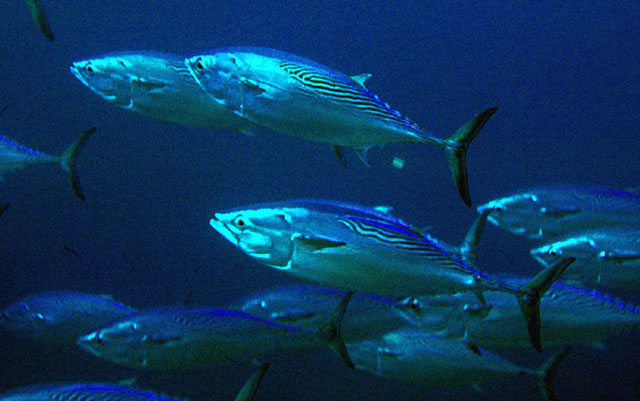
|
Euthynnus affinis (Cantor, 1849) Kawakawa |
||
| Anturayan, Barilis, Burawon, Kawakawa, Tulingan, Tulingan puti, Aloy, Bangkolisan, Bansikol, Bantala-an, Barilis, Boga-ongon, Buga-ongon, Bugaongon, Bulis, Hasa-hasa, Katsarita, Katsorita, Katsot, Mackerel tuna, Mangko, Manko, Minanga, Oceanic bonito, Pagadparon, Panit, Pidlayan, Pirit, Purupondahan, Reado, Sobad, Subad, Talingay, Tambacol, Tangi, Timbongan, Tulingan, Tulingan puti, Tulingang puti, Turingan, Using, Yaito bonito, Bagoong tulingan | ||

|
|
photo by
Field, R. |
| Family: | Scombridae (Mackerels, tunas, bonitos), subfamily: Scombrinae | |||
| Max. size: | 100 cm FL (male/unsexed); max.weight: 14 kg; max. reported age: 6 years | |||
| Environment: | pelagic-neritic; marine; depth range 0 - 200 m, oceanodromous | |||
| Distribution: | Indo-West Pacific: in warm waters including oceanic islands and archipelagos. A few stray specimens have been collected in the Eastern Central Pacific. Highly migratory. | |||
| Diagnosis: |
Dorsal spines (total): 10-15; Dorsal soft rays (total): 11-15; Anal spines: 0-0; Anal soft rays: 11-15; Vertebrae: 39-39. This species is distinguished by the following characters: medium-sized fish with a robust, elongate and fusiform body; teeth small and conical, in a single series; total gill rakers on first gill arch 29-34; D1 XI-XIV with both dorsal fins separated by only a narrow interspace (not wider than eye), anterior spines of first fin much higher than those midway, giving fin a strongly concave outline; D2 much lower than first and followed by 8-10 finlets; anal fin followed by 6-8 finlets; pectoral fins short, never reaching interspace between dorsal fins; 2 flaps (interpelvic process) between pelvic fins; very slender caudal peduncle with a prominent lateral keel between 2 small keels at base of caudal fin; body naked except for corselet and lateral line. Colour of back dark blue with a complicated striped pattern which does not extend forward beyond middle of first dorsal fin; lower sides and belly silvery white; several characteristic dark spots between pelvic and pectoral fins (but may not always be present) (Ref. 9684, 90102). Description: Swim bladder absent; no trace of vertebral protuberances; dorsal rays X-XV+11-15+8-10 finlets; anal rays 11-15+6-8 finlets; pectoral rays 25-29; maxilla extending posterior to middle of eye; jaw teeth are small and conical, about 25-35 on each side of lower jaw; presence of palatine teeth, none on vomer (Ref. 90102). |
|||
| Biology: | Occurs in open waters but always remains close to the shoreline. The young may enter bays and harbors. Forms multi-species schools by size with other scombrid species comprising from 100 to over 5,000 individuals. A highly opportunistic predator feeding indiscriminately on small fishes, especially on clupeoids and atherinids; also on squids, crustaceans and zooplankton. Caught in multispecies fisheries, mainly by surface trolling; also with gill nets. Generally marketed canned and frozen; also utilized dried, salted, smoked and fresh (Ref. 9684). | |||
| IUCN Red List Status: | Least Concern (LC); Date assessed: 01 March 2022 Ref. (130435) | |||
| Threat to humans: | reports of ciguatera poisoning | |||
| Country info: | Known from Hali-An Island, Mindanao (Ref. 58652) and Lanuza Bay (Ref. 104756). Also Ref. 168, 393, 9987. | |||